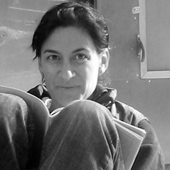
Edward Hicks, The Peaceable Kingdom, c. 1834
First, there was the deluge of Woodstock nostalgia over the past few months. Then, three separate emails mentioning Ernest Callenbach’s 1975 green counterculture classic, Ecotopia. And a sign on the bulletin board at my local grocer reading, “Will paint your house in exchange for a vehicle that runs.” All signs pointing to…the return of the commune.
But not of the sort you’re thinking of. “Hippies didn’t invent communes, and I’m not going to let them co-opt a great idea,” says Stephanie Smith, founder and CEO of WeCommune. “Things went wrong and now I want to single-handedly rebrand that great idea.”
Smith’s enthusiasm lay not in the sexualized, pot-smoking haze of the intentional communities of the ’60s but in the social and economic benefits of what she refers to as “communing” can offer. While technically a commune is defined simply as a community that shares resources, for Smith, a Harvard-trained entrepreneur and designer (she founded the EcoShack Design Studio+Lab in Joshua Tree, California, in 2003), it “seems like the answer to everything.”
WeCommune’s evolution is rooted in Smith’s artistic and architectural experimentation. She began marketing a green shelter known as the Nomad Yurt. In a design competition entry, she imagined the transformation from “cubicle to commune” and accordingly morphed a Steelcase cubicle into “a growing-corn-on-the-roof kinda thing.” A provocative T-shirt she designed, emblazoned with the slogan, “Wanna Start a Commune?” attracted enough attention that Levi’s asked to sell it in their stores. She is well aware that “commune” is a loaded term, and that’s the point. “It’s a visionary idea. Crazy but smart because it can offer an alternative to cash and credit economies that clearly aren’t working. It’s a third economic infrastructure.”
This year, Smith developed a technology platform that launched in beta form just a few weeks ago. It’s designed to give users a fast, flexible and entertaining way to share resources and build community with the people in their world. That world can be a neighborhood, an apartment building, a cul-de-sac or even a rock band. The point is that a group gets together for a common purpose that is rewarding both financially and emotionally. “You don’t share resources with people you’re not in close community with,” says Smith. “You can’t have one without the other.”
In describing her vision, Smith cites not just Callenbach but also Bucky Fuller, Colorado’s semi-anarchistic Drop City, Peter Coyote and the Diggers and the ’70s economic treatise Small Is Beautiful as influences. Rattling off commune stats that chart the failure of the storied sixties attempts (there were over 50,000 communes in 1967–1969, but less than 100 remained by 1972), she explains now that technology is the differentiator. That, and clear economic benefits. As she tells potential funders, “If we do this right, everyone will save $500 to $1,000 a month.”
Smith received seed funding for the launch of the platform and sees future earnings through an affiliate model of the sort seen at personal finance site mint.com. Costco, she reasons, already has a group buying club, so why not make it easier for WeCommune members (there are already 300 active communes registered on the site) to join? The site will also help facilitate leverage buying of things like solar panels and urban agriculture services. “You can be in a commune where you are now,” says Smith. “You can share and come together. It doesn’t have to be a radical act. This is not Facebook by any means, but it is meant to wake people up and bring them together.”
But not of the sort you’re thinking of. “Hippies didn’t invent communes, and I’m not going to let them co-opt a great idea,” says Stephanie Smith, founder and CEO of WeCommune. “Things went wrong and now I want to single-handedly rebrand that great idea.”
Smith’s enthusiasm lay not in the sexualized, pot-smoking haze of the intentional communities of the ’60s but in the social and economic benefits of what she refers to as “communing” can offer. While technically a commune is defined simply as a community that shares resources, for Smith, a Harvard-trained entrepreneur and designer (she founded the EcoShack Design Studio+Lab in Joshua Tree, California, in 2003), it “seems like the answer to everything.”
WeCommune’s evolution is rooted in Smith’s artistic and architectural experimentation. She began marketing a green shelter known as the Nomad Yurt. In a design competition entry, she imagined the transformation from “cubicle to commune” and accordingly morphed a Steelcase cubicle into “a growing-corn-on-the-roof kinda thing.” A provocative T-shirt she designed, emblazoned with the slogan, “Wanna Start a Commune?” attracted enough attention that Levi’s asked to sell it in their stores. She is well aware that “commune” is a loaded term, and that’s the point. “It’s a visionary idea. Crazy but smart because it can offer an alternative to cash and credit economies that clearly aren’t working. It’s a third economic infrastructure.”
This year, Smith developed a technology platform that launched in beta form just a few weeks ago. It’s designed to give users a fast, flexible and entertaining way to share resources and build community with the people in their world. That world can be a neighborhood, an apartment building, a cul-de-sac or even a rock band. The point is that a group gets together for a common purpose that is rewarding both financially and emotionally. “You don’t share resources with people you’re not in close community with,” says Smith. “You can’t have one without the other.”
In describing her vision, Smith cites not just Callenbach but also Bucky Fuller, Colorado’s semi-anarchistic Drop City, Peter Coyote and the Diggers and the ’70s economic treatise Small Is Beautiful as influences. Rattling off commune stats that chart the failure of the storied sixties attempts (there were over 50,000 communes in 1967–1969, but less than 100 remained by 1972), she explains now that technology is the differentiator. That, and clear economic benefits. As she tells potential funders, “If we do this right, everyone will save $500 to $1,000 a month.”
Smith received seed funding for the launch of the platform and sees future earnings through an affiliate model of the sort seen at personal finance site mint.com. Costco, she reasons, already has a group buying club, so why not make it easier for WeCommune members (there are already 300 active communes registered on the site) to join? The site will also help facilitate leverage buying of things like solar panels and urban agriculture services. “You can be in a commune where you are now,” says Smith. “You can share and come together. It doesn’t have to be a radical act. This is not Facebook by any means, but it is meant to wake people up and bring them together.”

